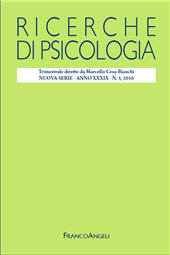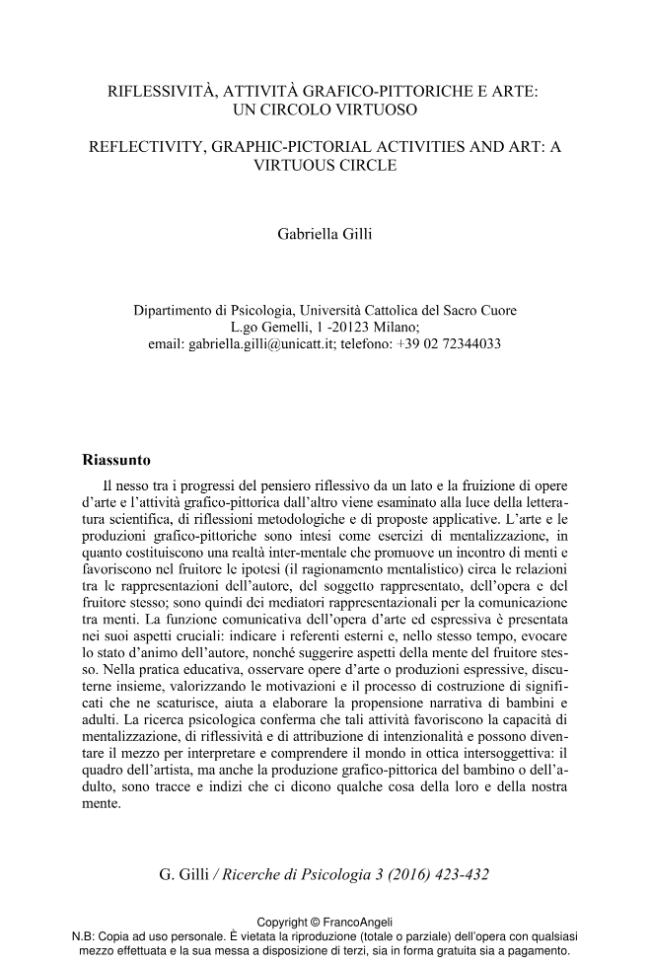Riflessività, attivita grafico-pittoriche e arte : un circolo virtuoso
423-432 p.
Reflectivity, graphic-pictorial activities and art: a virtuous circle.
Il nesso tra i progressi del pensiero riflessivo da un lato e la fruizione di opere d'arte e l'attivita grafico-pittorica dall'altro viene esaminato alla luce della letteratura scientifica, di riflessioni metodologiche e di proposte applicative. L'arte e le produzioni grafico-pittoriche sono intesi come esercizi di mentalizzazione, in quanto costituiscono una realta inter-mentale che promuove un incontro di menti e favoriscono nel fruitore le ipotesi (il ragionamento mentalistico) circa le relazioni tra le rappresentazioni dell'autore, del soggetto rappresentato, dell'opera e del fruitore stesso; sono quindi dei mediatori rappresentazionali per la comunicazione tra menti. La funzione comunicativa dell'opera d'arte ed espressiva e presentata nei suoi aspetti cruciali: indicare i referenti esterni e, nello stesso tempo, evocare lo stato d'animo dell'autore, nonche suggerire aspetti della mente del fruitore stesso. Nella pratica educativa, osservare opere d'arte o produzioni espressive, discuterne insieme, valor
izzando le motivazioni e il processo di costruzione di significati che ne scaturisce, aiuta a elaborare la propensione narrativa di bambini e adulti. La ricerca psicologica conferma che tali attivita favoriscono la capacita di mentalizzazione, di riflessivita e di attribuzione di intenzionalita e possono diventare il mezzo per interpretare e comprendere il mondo in ottica intersoggettiva: il quadro dell'artista, ma anche la produzione grafico-pittorica del bambino o dell'adulto, sono tracce e indizi che ci dicono qualche cosa della loro e della nostra mente. [Testo dell'editore].
The link between the reflective thought and enjoyment of works of art and other graphic-pictorial activities is examined in the light of the scientific literature, methodological issues and practical proposals. The art and graphic-pictorial productions are intended as mentalistic exercises, as they form an 'inter-mental reality' that promotes a 'meeting of minds' and trigger the hypotheses (mentalistic reasoning) about the relationship between the representations of the author of the artwork, the subject depicted in the artwork, the artwork and the viewer herself. They are therefore representational mediators for communication between minds. Their communicative function is presented in its crucial aspects: Indicate the external references and, at the same time, evoke the author's state of mind, as well as suggesting aspects of the mind of the viewer himself. In educational practice, observing or producing expressive works, discussing them, enhancing the process of construction of meanings that emerges, helps.
to process the narrative and reflective tendency of children and adults. Psychological research confirms that these activities support the mentalistic ability, the reflectivity and intentionality attribution and can become the means to interpret and understand the world in an intersubjective perspective: the artist's painting, but also the graphic and pictorial production of a child or an adult, are traces and clues that tell us something of their mind and of our own mind. [Publisher's Text].
Fait partie de
Ricerche di psicologia : 3, 2016-
Articles du même numéro (disponibles individuellement)
-
Informations
Code DOI : 10.3280/RIP2016-003011
ISSN: 1972-5620
KEYWORDS
- Attivita grafico-pittoriche, arte, pensiero riflessivo, ragionamento mentalistico
- Graphic-pictorial activities, art, reflective thought, mentalistic reasoning



